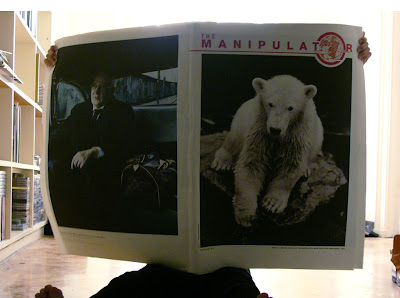







THE MANIPULATOR magazine was born in 1984 into a world almost unimaginable today: no cell-phones, no internet, no Adobe Photoshop, no digital cameras. In those quondam times, it was the cordless phone, the fax machine, the colour-copier and the Apple IIc that defined the technologically savvy.
That same year, Michael Jackson nabbed seven Grammys for Thriller and Madonna, with her rendering of Like A Virgin at the first-ever MTV Awards show, shocked audiences — not for the last time. While the future-governor was just being introduced as The Terminator, Amadeus went on to win the Academy Award for best picture. Virgin Atlantic took to the skies and Indira Gandhi was laid to rest. Between them, Margaret Thatcher, Ronald Reagan and Ruhollah Khomeini were looking after things. It all seems such a long time ago. And so it was.
Nonetheless, 1984, and the remainder of the decade, were the golden years of independent publishing. Warhol had already set the ball rolling in the 1970s with Interview, his magazine dedicated to the cult of celebrity, a matter some in the industry huffily dismissed as too inconsequential to warrant much attention.
By the time the ‘80s dawned, Nick Logan’s The Face in London and Annie Flanders’s Details in New York had set the stage for a new kind of magazine. Though each focused on a specific theme — the UK music scene in the case of the former; the Downtown-New York club scene in that of the latter – they, in effect, presaged the “lifestyle” publications that would flood the market a decade later. Emboldened by the success of these non-establishment periodicals, and by the public’s obvious hunger for such eclectic material, a whole slew of magazines had hit the stands in Europe & the US by the mid- 1980s: Egoïste, Metropolis, I-D, City, Blitz, Vibe, Paper, just a few of the many that honed in on the expanding and varied interests of the populace. One of which was photography.
The once-rigid separation between commercial and fine-art photography was fast collapsing and some of the most exciting, new work began appearing, not on gallery walls, but in magazine editorials and advertising campaigns. With the drama of photographic aesthetics being played out on so egalitarian a stage, everyone was soon spectator, analyst, arbitrator and fan. THE MANIPULATOR was a champion for photography. Over-large format had been used on occasions in the past, particularly for picture-heavy publications, ,but THE MANIPULATOR was the biggest by far, able to reprint images in gargantuan, poster-like proportions. Its content reflected an obvious bias towards architecture, design, art and photography, but it was also one of the first consumer magazines to start addressing the looming ecological plight facing the world.
Deforestation, rising sea-levels, suspect animal-husbandry, acid-rain: these were issues regularly confronted in the pages of THE MANIPULATOR, made all the more compelling by the huge pictures that accompanied the articles.
Archival photography was another favourite. Hand-tinted images taken in Japanese brothels in the late- 1800s; sepia- toned shots of Spanish bull-fighters from the turn of the century; murky photographs from the albums of the Victorian Egyptologists: all found a home in the pages of THE MANIPULATOR. When the USSR began crumbling under the onslaught of Gorbachev’s glasnost, the Novosti archives, which had been closed to the world since the revolution of 1917, were made available for reproduction in a 1989-edition of the magazine.
The romance between THE MANIPULATOR and photography as a platform for advertisements for trendsetting companies and brands for would last ten years. The decision to cease publication in 1994 was a relatively easy one – better to end it all while the magazine was still cherished and esteemed. The odd back-issue of THE MANIPULATOR would pop up as part of the set-dressing on a movie, or grace a popstar’s album cover, or be a prop in some music video, or a feature in some exhibit. Even Helmut Newton admitted to its influence when he published his same-sized Helmut Newton’s SUMO. THE MANIPULATOR was a revolution in its time ; the true trendsetting magazine in the worlds largest format.
My brother, Brad Branson and Fritz Kok created the cover for issue #11. Brad passed late last year and I am searching for a copy. Any help would be greatly appreciated. janlane22@gmail.com
ReplyDeleteMy brother, Brad Branson and Fritz Kok created the cover for issue #11. Brad passed late last year and I am searching for a copy. Any help would be greatly appreciated. janlane22@gmail.com
ReplyDelete